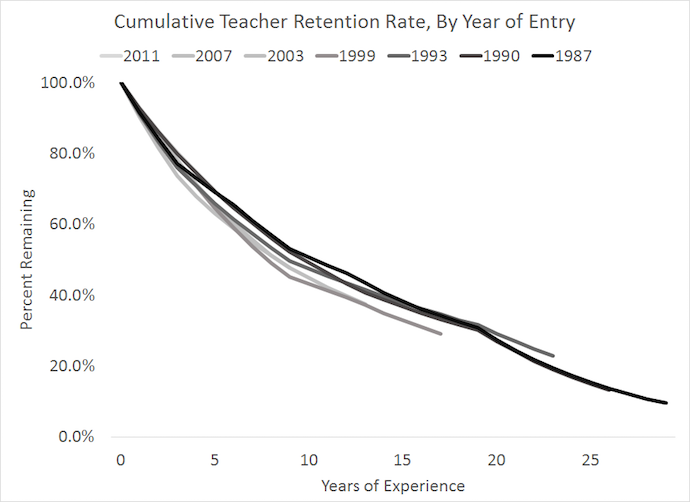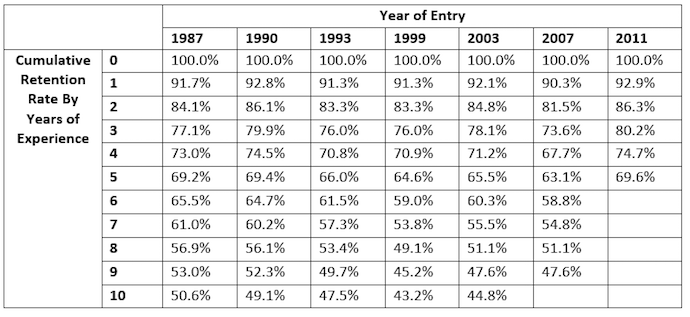Everyone knows that teacher turnover rates are rising. So even though they’ve declined a bit recently, over the long term, national teacher turnover rates are up.

But what if the national, composite data aren’t the right way to look at teacher retention?
As I’ve written before, overall teacher retention rates are partly a function of teacher demographics. In general, retention rates for all workers — teachers included — follow something of a U-shaped pattern. Turnover rates are high for teachers early in their careers, decline over time and plateau mid-career, and then rise again near retirement. So if you combine all teachers into one overall average, your results will depend on what proportion of teachers fall into each of these career stages.
A better way to think about teacher retention would be to look at how many teachers reach various career milestones. That would allow a cleaner apples-to-apples comparison by looking at teachers who began their careers at different points in time. The National Center for Education Statistics (NCES) runs regular surveys that follow cohorts of teachers for a few years, but there’s no national dataset that I’m aware of that tracks individual teachers over long periods of time.
We can, however, use the NCES data to back into a reasonable approximation. NCES breaks down turnover rates* by teacher experience levels (1-3, 4-9, 10-19, and 20+ years of experience), and they update the data with new survey results every few years. By using these rates and updating them over time, we can synthetically “follow” cohorts as they age into the profession.
For example, NCES’ oldest teacher survey began in 1987-88. In that year, it found that 8.3 percent of teachers with 1-3 years of experience left the profession (meaning 91.7 percent remained). We can assume this group of teachers had the same turnover rate in years two and three (1988-89 and 1989-90). In year four, this group would jump to a new NCES experience category (teachers with 4-9 years of experience). Additionally, NCES released a new set of estimates in 1990-91, so the estimates must shift accordingly.
Using this method, I ran the numbers for the cohorts entering in 1987, 1990, 1993, 1999, 2003, 2007, and 2011. The graph below is the result.

The main takeaway from this analysis is that, contrary to conventional wisdom, teacher retention rates don’t seem to be changing that much.** The national averages appear to be deceiving us. Regardless of the year they started, about one-third of teachers had left within five years, and about half were gone within 10 years. Teacher retention doesn’t seem to be changing that much.
Since the graph is somewhat hard to read, here’s what the data look like in table form. Each column represents a starting year, and the rows indicate the cumulative retention rate by years of experience.

What is really going on here? I suspect two dominant trends have been shaping the national narrative about the changing teaching workforce. First, schools lowered student/teacher ratios by hiring more teachers than they lost. That meant schools were hiring lots of inexperienced teachers, which enhanced the feeling of system-wide churn even as underlying rates of teacher turnover didn’t actually change. Specific policy choices led us to a larger but less-experienced teacher workforce.
Second, even as districts were hiring lots of inexperienced teachers, the teaching workforce also got older. Existing teachers got older as the Baby Boom generation aged into the workforce, and even new hires were older than previous cohorts of new teachers. Due to retirement, older workers have high turnover rates, feeding into the feelings of higher churn.
These two trends could have shifted our perceptions of the teacher workforce even as the underlying dynamics didn’t change much at all. The analysis I’ve presented here suggests that the changing mix of teachers employed in our schools may be deceiving us. Teacher turnover rates aren’t rising, but we are employing more teachers who fall into career stages with high turnover. That’s a different, more complicated story.
*For simplicity’s sake, I’m counting all teachers who stay in the profession as being retained. That is, I’m assuming retention is 100 percent minus the NCES “leaver” rate. There’s another group of teachers, “movers” who change schools, but this analysis is looking only at overall, cumulative teacher retention on a national basis.
** There are couple distinctions worth noting. First, the 1999, 2003, and 2007 cohorts all have slightly lower retention rates than prior groups of teachers. The differences aren’t that large—only a few percentage points—but they are visible. I don’t have a good explanation for why those years in particular were lower, but it may have been temporary. The cohort that began in 2011 is more in line with the earlier years and, in fact, has the highest 5-year retention rate of any cohort.
There’s also a visible kink at the 20-year mark. While late-career teachers do have high turnover rates, that’s mainly a function of retirement. They show up here at the 20-year mark due to the NCES categories. Because NCES lumps all teachers with 20 or more years of experience into one category, that captures a lot of teachers who are retiring. The high rates of retirement make the entire category have high turnover rates.
—Chad Aldeman
Chad Aldeman is a principal at Bellwether Education Partners.
This post originally appeared on TeacherPensions.org.


